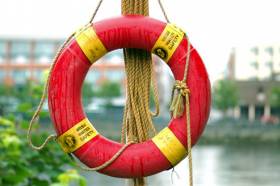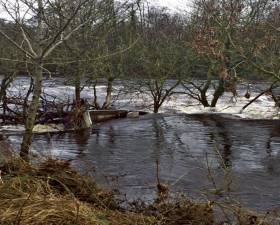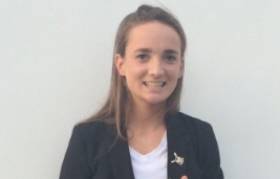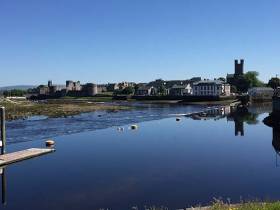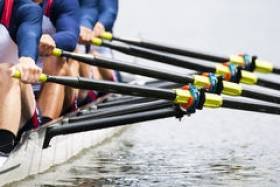Displaying items by tag: Limerick
Man Recovered From Shannon After Leaving Taxi On Limerick City Bridge
#Rescue - Swift water rescuers from the Limerick Fire Service raced to the aid of a man from the River Shannon in the city centre last night (Friday 10 February).
As BreakingNews.ie reports, the casualty had entered the water at Shannon Bridge after leaving a taxi on the bridge around 10pm.
Passers-by threw the man a life buoy which kept him afloat till the rescue boat arrived just minutes later, recovering him to the slipway at St Michael's Rowing Club for treatment before transfer to hospital.
Boating Under Influence Led To Shannon Tragedy Says MCIB Report
#MCIB - The dangers of boating while under the influence have been highlighted in the official report into an incident on the Shannon near Limerick city earlier this year.
One man died and three others were hospitalised after their boat capsized north-east of Limerick city in the early hours of Thursday 4 February, as previously reported on Afloat.ie.
The official report into the incident by the Marine Casualty Investigation Board (MCIB) has found that the four men, none of whom had any boating experience, were under the influence of alcohol and/or drugs when they took the boat from Castleconnell Boat Club shortly before 4am.
The small aluminium boat had its drain plug removed, as is standard when storing such boats ashore, and quickly began taking on water as the four men paddled to an area known as the Gap of the Dam, where the river narrows, and into a torrent fed by heavy rainfall in the previous fortnight.
Losing control of the boat as they guided it to trees on a spit of land in the river, it grounded on submerged rocks and capsized, throwing all four men into the water. None were wearing lifejackets.
One man caught his leg under the capsized boat, another was swept away while attempting to lift the boat off his friend, and a third became entangled in undergrowth after losing his footing, while the fourth managed to contact emergency services with his mobile phone after several attempts.
Gardaí and teams from the Limerick Fire Service and Killaloe Coast Guard arrived between 4:35am and 4:45am but faced great difficulty mounting a rescue attempt due to the fast-flowing water and low light conditions, though all four were recovered by 7am.
Two firemen were commended by the MCIB for their courage in staying in the water for over two hours to assist the man trapped in undergrowth, though he was unresponsive when finally recovered from the water and later pronounced dead due to drowning at Limerick University Hospital.
Impaired judgement due to drugs and/or drink taken over a number of hours was cited as the main factor in the tragedy by the MCIB, explaining the men’s recklessness in taking out a boat in darkness with no experience and lacking safety gear.
The board recommends the issue of a Marine Notice reminding the public of the dangers of operating any water craft under the influence.
The full report from the MCIB is available to download below.
O'Connor So Close at Provinces Indoor Rowing
#Rowing: Eoghan O’Connor of Castleconnell came agonisingly close to a remarkable feat at the Irish Provinces Indoor Rowing Championships at the University of Limerick today. The Castleconnell man missed setting a time of six minutes for the 2,000 metres by just one tenth of a second. Cathal Cummins of Lee Valley set a fine time of six minutes 30.5 seconds in the under-18 grade.
Jess O’Keeffe of University of Limerick won the women’s open grade in 7:20.1, but Margaret Cremen of Lee was the fastest woman, with an excellent time of 7:15.2.
Irish Provinces Indoor Rowing Championships, University of Limerick
Men
Open: E O’Connor 6:00.1. Lightweight Open: D O’Connor 6:30.5. Under-23: G Patterson 6:18.9. Lightweight Under-23: B McKeon 6:42.9. Jun 18: C Cummins 6:20.5. Jun 16: R Tummon 6:31.8. 30-39: R Corcoran 6:30.8.
Women
Open: J O’Keeffe 7:20.1. Under-23: H O’Sullivan 7:21.8. Lightweight Under-23: E McGiff 7:43.3. Jun 18: M Cremen 7:15.2. Jun 16: C Kirwan 7:27.9. 30-39: M Tritt 7:40.3.
Updates On Inland Waterways Summer Works & Closures
#InlandWaters - Waterways Ireland advises that remedial works have commenced on the stretch of the Shannon Navigation between Limerick City and Parteen Weir after significant storm and flooding damage over the winter.
The closure had caused some consternation within the boating community as it effectively excluded Lough Derg sailors from this summer's WIORA races, and threatened to hit maritime revenues in Limerick.
But it was announced recently that design options had been advanced to provide for works to be completed this month.
It's believed that works on the affected infrastructure will be completed by the week beginning Monday 25 July. Prior tooth time, a schedule of opening times will be published for Sarsfield's Lock.
In other inland waterways news, the Barrow Line of the Grand Canal has been closed since Monday 11 July until forth notice due to a culvert collapse between Locks 22 (Glenaree Bridge) and 23 (Spencer Bridge). Further notice will be issued once the damage has been assessed.
Meanwhile, on the River Bann, Carnroe Lock has been closed for emergency repair works, which are expected to be completed within the next two weeks.
There's better news on Upper Lough Erne, however, as the public mooring jetty and slipway at Carrybridge is now open, with the exception of the pump-out facility.
St Joseph's of Galway Trophy Winners at Schools' Championships
#Rowing: The Victor Ludorum Trophy for best school was won by St Joseph’s of Galway at the Irish Schools’ Championships at O’Brien’s Bridge in Clare today. Daire Lynch of Clonmel CBS was the best single sculler. Methodist College, Belfast, won the women’s under-23 eight.
#Rowing: A horde of Irish records fell at the Irish Indoor Rowing Championships at the University of Limerick today. Sanita Puspure set a new time for the women’s open category of 6 minutes 36.7 seconds. The second fastest time was also a record, as 17-year-old Emily Hegarty clocked 6:57.0, lopping over two seconds off the old junior record set by Lisa Dilleen. Claire Lambe’s time of 7 minutes 12.6 seconds was a new Irish record for a lightweight woman.
Paul O’Donovan set an excellent time for the lightweight under-23 category – 6:07.5 – over two seconds better than his previous personal best. His brother and soon-to-be Olympic crewmate, Gary, had been the fastest in the open lightweight section, with a time of 6:14.6. The men’s junior 18 category was won by Cathal Cummins in a new Irish record of 6:16.2. Sam McKeown’s hopes of breaking six minutes in the men’s open category fell short, though his time of 6:02.9 was 1.8 seconds better than his previous best.
Other record breakers on the day included Paul Gallen (lightweight men, 60 to 69), Niall O’Brien (open, 50-59), Priscilla O’Sullivan (women’s open, 50-59) and Catherine McKeon (pararowing, legs trunk and arms).
Irish Indoor Rowing Championships, University of Limerick, Saturday (Selected Results)
Men
Open: 1 S McKeown 6:02.9, 2 T Oliver 6:03.2, 3 P Buchanan 6:09.6, 4 P Doyle 6:10.7, 5 D Brown 6:13.0, 6 K Coughlan 6:13.1. Under-23: 1 J Casey 6:18.3, 2 D Mitchell 6:18.5, 3 P Munnelly 6:19.7. Junior 18: 1 C Cummins 6:16.2, 2 R Byrne 6:16.7, 3 D Lynch 6:18.3. Jun 16: R Tummon 6:38.2.
Lightweight – Open: 1 G O’Donovan 6:14.6, 2 M O’Donovan 6:18.0, 3 S O’Driscoll 6:18.8, 4 L Keane 6:24.8.
Under-23: 1 P O’Donovan 6:07.5, 2 S Mulvaney 6:21.8, 3 L Seaman 6:25.7
Pararowing – LTA (1,000m): S Ryan 3.30.6.
Women
Open: 1 S Puspure 6:36.7, 2 M Dukarska 6:58.9, 3 L Kennedy 7:01.9, 4 A Keogh 7:06.1, 5 S Bennett 7:13.8, 6 R Maguire 7:15.0. Under-23: 1 S Bounane 7:16.8, 2 E Lambe 7:18.6, 3 S Murphy 7:30.1. Junior 18: E Hegarty 6:57.0, 2 H Scott 7:20.7, 3 M Cremin 7:23.6. Jun 16: C Nic Dhonncha 7:35.6.
Lightweight – Open: 1 C Lambe 7:12.6, 2 Sarah Dolan 7:17.0, 3 S McCrohan 7:18.4. Under-23: E McGiff 7:41.9.
Pararowing – LTA (1,000m): C McKeon 3:37.1.
Best Overall Club (Eddie Crean Trophy): St Joseph’s, Galway
Rio Olympians Sign Up for Irish Indoor Rowing Championships
#Rowing: The entry for the Irish Indoor Rowing Championships has both quantity and quality, with Irish rowers who are set to compete at the Olympic Games in the mix. Gary O’Donovan will compete in lightweight class and Paul O’Donovan in the under-23 lightweight class.
Claire Lambe, who partnered Sinéad Jennings in the Ireland lightweight women’s double crew which qualified the boat for Rio, is also entered. Jennings may do a Wattbike test.
Among the heavyweight men, Philip Doyle, Sam McKeown and Dave Neale will be among those competing to set the top mark, while Sanita Puspure, an Olympian in 2012, should be the fastest woman.
The Championships have a record entry and will be held in Limerick on January 23rd.
Rix and Byrne are Afloat Rowers of the Month
#Rowers of the Month: The Afloat Rowers of the Month for November are Barney Rix of Portora and Ronan Byrne of Shandon. The two young men set new Irish records in indoor rowing. Byrne set a new junior record of six minutes 16.9 seconds at the Provinces Indoor Championships in Limerick. Rix, who had won the junior section at the Irish Indoor Championships early in the year, competed just two days after the Limerick test in Enniskillen – and lowered the record by .1 of a second to 6:16.8.
Rower of the Month awards: The judging panel is made up of Liam Gorman, rowing correspondent of The Irish Times and David O'Brien, Editor of Afloat magazine. Monthly awards for achievements during the year will appear on afloat.ie and the overall national award will be presented to the person or crew who, in the judges' opinion, achieved the most notable results in, or made the most significant contribution to rowing during 2015. Keep a monthly eye on progress and watch our 2015 champions list grow.
# Sam McKeown of Portadown set a time of six minutes 4.7 seconds, the fastest at the Ulster Indoor Championships at Queen’s University, and a personal best for the under-23 competitor. In Limerick, Richard O’Hagan won the open and 500 metres categories at the Irish Provinces Indoor Championships, with times of 6:09.4 and 1:19.6. NUIG had a good day, and Liam Keane (also under-23) was the fastest lightweight.
Junior 18 competitor Ronan Byrne of Shandon set a new record for the 2,000 metres of 6:16.9, while fellow junior Eoghan Walls-Tuite set an excellent time of one minute 22.3 seconds for 500 metres.
Monika Dukarska of Killorglin was the fastest woman, and Siobhán McCrohan the fastest lightweight woman.
Irish Provinces Indoor Rowing Championships, University of Limerick (Selected Results; 2000 metres unless stated)
Men
Open – 1 R O’Hagan 6:09.4, 2 F Crowley 6:24.9, 3 A Prendergast 6:25.5. 30-39: G Conway 6:19.7. Open 500: R O’Hagan 1:19.6.
Under-23: A Kinneen 6:20.2. Junior 18: R Byrne 6:16.9, 500: E Walls-Tuite 1:22.3.
Jun 16: J Keating 6:33.8, 500: J McCarthy 1:29.8.
Jun 15 (1,000): R MacCurtain 3:23.6.
Freshers (1,000); G Barlow 3:05.2.
40-49: N Carey 6:24.3, 500: Carey 1:23.9. 50-59: O Short 6:46.9, 500: Short 1:29.4. 60-69: P Victory 6:57.6, 500 (60+): P Victory 1:32.6.
Lightweight – Open: D O’Connor 6:33.5, 500: L Keane 1:28.9.
Lightweight Under-23: L Keane 6:25.0, 500: Keane 1:28.9. Lightweight 40-49: J Doyle 6:29.1.
Women
Open – 1 M Dukarska 7:02.7, 2 A O’Sullivan 7:19.0, 3 M Piggott 7:34.7. 500: M Dukarska 1:33.6.
Under-23: S Bounane 7:18.7. Junior 18: M Cremin 7:23.3.
500: M Cremin 1:38.8.
Jun 16: A O’Farrell 7:32.7, 500: L Turner 1:44.1.
Jun 15: (1,000): A Doyle 3:50.6, 500: J Crowley 1:41.1
Freshers (1,000): B Chase 3:43.2.
30-39: S Kennelly 7:24.9. 40-49: P O’Brien 7:51.8, 500: R Ware 1:43.3. 50-59: M Lawlor 8:11.2, 500: Lawlor 1:55.9.
Lightweight – Open: S McCrohan 7:14.7, 500: K Wilkie 1:44.4.
Lightweight Under-23: E McGiff 7:49.2.
Lightweight 30-39: C Conway 7:48.3.
LTA – S McLoughlin 3:51.1, 500: McLoughlin 1:51.0.
Ulster Indoor Rowing Championships, Queen’s University, Saturday (Selected Results, 2,000 metres unless stated). Includes BUCS: British University Championships.
Men
Open: S McKeown 6:04.7, 2 M Christie 6:25.9. BUCS Open: 1 T Oliver 6:10.6, 2 P Doyle 6:26.9, 3 R Urquart 6:34.7. BUCS Lightweight: C Beck 6:31.2.
Under-23 Lightweight: A Laivinas 6:50.3.
Under-18: D Mitchell 6:26.0. Under-16: A Christie 6:39.3. Under-15: A Graham (1,000m) 3:32.7.
BUCS Beginners (1,000): J Lobinger 3:11.4.
Women
Open: R Maguire 7:15.4. BUCS Open: Maguire 7:15.4. BUCS Open Lightweight: R Brown 7:46.7.
Under-23: K Shirlow 7:28.3.
Under-18: F Chestnutt 7:31.0.
Under-16: L McIntyre 7:46.2. Under-15 (1,000m): A Hall 3:54.6. 30+ (1,000m): L Kerr 3:20.9.
BUCS Beginners (1,000m): A Druijff 3:45.8.
Teens Rescued From Drifting Boat On River Shannon
#Rescue - Three teenagers were rescued by Limerick emergency services on Friday night (11 September) as their boat drifted out of the city along the River Shannon, as BreakingNews.ie reports.
The small fishing boat has experienced engine trouble and run out of fuel, leaving the three on board adrift till they were retrieved and their boat towed to safety.
It was the second callout to the river on Friday for the Limerick City Fire and Rescue Service, after a man fell into the river from Sarsfield Bridge in the early hours.
BreakingNews.ie has more on the story HERE.


























